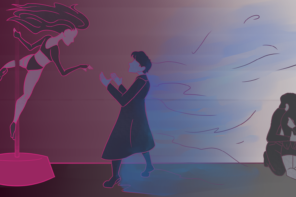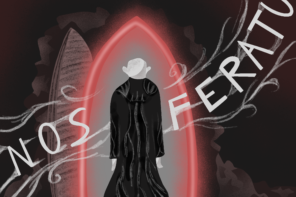1917 exists, first and foremost, to give itself a medal of honour: a war film made to look like two spatiotemporally continuous shots (separated by a shocking cut-to-black at the film’s midpoint), meant to put you directly in the shoes of two average lads trekking to the southwestern front to deliver a message halting an attack. To that end, its greatest scene takes place in the devastated city of Ecoust, where a roving firelight sculpts a shattered maze of broken stone buildings as our silhouetted bloke sneaks and sprints through. Director of photography Roger Deakins’ work here is nothing short of heroic; his coordination of lighting and lensing and extras, in some scenes hundreds of them, is the work of a master at the peak of his craft. In fact, not since 2015’s The Revenant has so much skillful production coordination and cinematographic flexing been leveraged towards such an irritating, vacuous slog.
The thing about the one-shot gimmick is that, at its core, it’s an awful idea: Hitchcock figured this out in 1948 when he shot Rope this way (partly to see if it was even possible – he concluded that it wasn’t) by continually zooming into characters’ backs. As it turns out, the one-take format forces awkward angles and bad staging, suffocates moments of drama and tension just to prolong its existence. And yet, Rope remains the best film ever shot in this style because Hitchcock is the best filmmaker to ever take it on; his mastery of tension and drama almost rescues the gimmick from itself. It seems that the only filmmakers who arrogantly feel they can do what Hitchcock couldn’t are egomaniacal first-timers who don’t know any better (see Victoria (or, better yet, don’t)) and emotionally adolescent hacks with stalling careers (Birdman, Russian Ark, and now 1917).
So we’re sacrificing both moments of tension and moments of emotion, because… wait, why the hell are we doing this one-take thing again?
For a practical primer of how this format hurts 1917, let’s consider two examples. First, there’s the business with the rat in the bunker: in the background of one frame, a big german rat scurries along a pole and our two central lads remark upon its size. About a minute later, the boys discover a tripwire intended to blow the whole bunker up should intruders come in. Then, the rat returns, and oh no, it’s scurrying towards the tripwire! A terrifically tense setup… except that we can’t get a close-up on the rat, nor can we show the spatial relationship of the rat and the tripwire, nor can we emphasize the boys’ futile efforts to stop the rat, because, well, we’ve restricted ourselves from doing these things. Where there could be thirty seconds of grueling tension, instead, rests a few paltry frames of shock.
Second, there’s the orchard, where a character meets an untimely death surrounded by blossoming trees that have been cut down by the German forces; beautiful life cut short by this terrible war machine. The metaphor is made brutally clear by the character’s declaration upon seeing the orchard that, “me mum’s got an orchard back home… so at least I’ve got something to return to.” Thuddingly obvious, sure, but that’s perfectly fine. It’s an inherently melodramatic setup that’s positively begging for a purposefully melodramatic framing: put his dead body in between the trees! Except, we can’t do that, because the camera cannot travel over there, and of course we can’t just cut. So we’re sacrificing both moments of tension and moments of emotion, because… wait, why the hell are we doing this one-take thing again?
Well, we have to remember who we’re dealing with here: nobody has a track record of mobilizing immense talent towards realizing awful ideas like Sam Mendes. Having previously made the world’s least essential Darkness In Suburbia film (two of them, in fact) and the world’s least essential mob movie, he’s set his sights on making a war film even less diverting than his previous Jarhead. In terms of baffling noxiousness, he’ll probably never top American Beauty, the worst Best Picture winner in the history of the Academy Awards, but his quest to keep trying is perversely admirable.
The signature Mendes touch, beyond overseriousnous and boredom and thudding heft (all of which are here in spades), is the vigorous expression of stale ideas as if Mendes was the first to ever discover them; what else could possibly happen after winning an Oscar for making your very first film about how the American suburbs… aren’t what they seem. This is a film for people who are still deeply moved by the sentiment that beauty can bloom, even on the battlefield; a film for people who see an infant child in a war zone and are genuinely urged to think about What It All Means, This Thing We Call Life; a film for people who are new to the idea that even though human beings so often hurt each other, sometimes… they help each other out. It’s a film for people who cried watching War Horse.
You’ll understand then, that when I see other publications call this movie a triumph of experimental filmmaking, I feel a migraine growing stronger and stronger. 1917 does positively nothing that wasn’t done far better far earlier in films like All Quiet On the Western Front, or Paths of Glory, or The Ascent, or Apocalypse Now, or Dunkirk, or especially Saving Private Ryan, which this film lifts from at every turn without realizing that Spielberg’s virtuoso montage and blocking is the exact counterargument to this film’s entire existence as a shallow one-take spectacle.
After all, we’re talking about a man who rejected a Radiohead Bond theme in favour of Sam Smith.
Long takes can indeed be powerful, but in order to reach this power, they must be contrasted with something. 1917 ultimately builds to a moment where the last lad standing, with the clock running down and the bombs flying high, climbs above the trenches and runs for his life – a moment where the long take is absolutely the right choice. Just imagine the film we would’ve had if Mendes had withheld the long take until that very moment. What dooms Mendes’ message, beyond his corniness (which can be excusable, see my previous exaltation of Spielberg) is his complete and utter tastelessness; after all, we’re talking about a man who rejected a Radiohead Bond theme in favour of Sam Smith.
More than just being obnoxious and boring, 1917 is misjudged from its very conception, operating on a complete mismatch of its formal approach and its dramatic one. It hinges on letters never sent, minimal gestures of kindness, held back tears, and also big-dick camera moves and epic explosions. It is a film about repression, masculine stoicism, and minimalist displays of emotion, which is constitutionally incapable of representing that restraint in its form – a film about quiet emotion that expresses nothing quietly. War is hell… now look at how cool it is! I imagine that the grips and best boys and camera assistants, not to mention DP Deakins, felt like those engineers who built the German war machines. All these rigs and contraptions and engineering and absurd lighting setups, all this technological heft… for this?
In conclusion, 1917 deserves the Academy Award for Best Picture.








